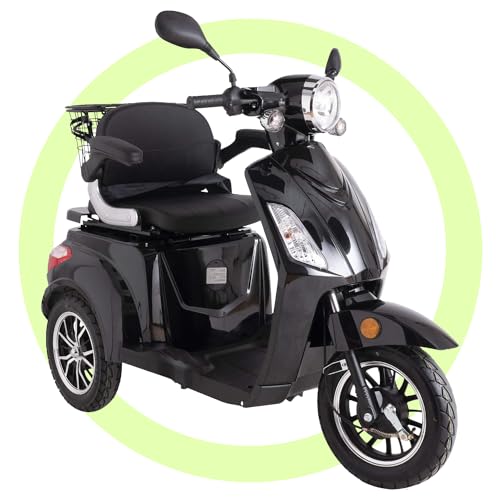9 Lessons Your Parents Taught You About Green Mobility
페이지 정보

본문
 What Is Green Mobility?
What Is Green Mobility?Green Mobility develops corporate programs to cut down on commutes by private motor vehicles in cities. This does not just reduce traffic congestion, but also improves public transportation and the quality of life.
green power mobility scooters uk mobility can be used to reduce air pollution, climate impact, and promote an active lifestyle. Examples of green mobility are:
Interventions in the Policy Process
A array of policy instruments could aid in go green mobility scooters mobility. The first category includes spatial strategies that aim to limit the traffic of urban vehicles and encourage the use of sustainable transportation modes. These tend to be small-scale interventions (e.g., restrictions on parking spaces or speed limits or the use of cycle lanes) and have a high degree of flexibility, since they can be adapted to local conditions.
Another set of policies seeks to change the modal structure by promoting alternative fuels for vehicles and technologies (e.g. EVs) or by encouraging sharing of vehicles and routes. These policies can also include measures to increase accessibility to public transportation services, such as through financial incentives or more mobility options.
The promotion of green mobility can also involve changes in the business model in terms of economic development, land-use planning. This requires political will, and a high degree of coordination between sectors. In addition, it should be noted that a broad and fair shift to green power mobility mobility requires the elimination of existing inequalities. In cities with the highest concentration of high-value sectors of employment like business services and information and communication technology growing green mobility scooter mobility can result in an increase in access for communities of upper and middle classes, while reducing opportunities and jobs in neighbourhoods of lower income.
A third set policy instruments aims to reduce negative externalities related to transportation and promotes more sustainable energy sources like renewables and carbon pricing. These policies can be enacted at a local, national or EU level. They can be in the form of a tax or fee on the ownership of a vehicle and its operation or more comprehensive regulation of vehicle usage. They can also promote the development of electric vehicles and charging infrastructures, and encourage a switch to sustainable modes of transportation. Locally, this might mean creating initiatives to promote sustainability and establishing a sustainable habit through education, awareness campaign and a variety of other initiatives. At the national and EU levels, it can involve leveraging global economic stimuli to encourage consumer purchases of EVs and the expansion of high-speed rail systems, and also assisting research and development in the field of hydrogen and batteries.
EV Adoption
The speed at which cars change from traditional internal combustion (IC) to electric power is influenced by a variety of factors. One of them is that the economic condition of a country and the policies of its government determine how EV adoption can increase. Historically, high-income nations like Norway and China, have been the leaders in this field with their strong support of both EV production and consumer incentive programs. These financial incentives helped to create an energetic EV industry which resulted in lower costs.
These countries also have strong policies regarding energy that encourage sustainable energy use. In addition, they prioritize the development of a large public charging infrastructure to alleviate the anxiety about range for new EV consumers. This strategy has had a positive effect on overall EV adoption, as shown in the vehicle-in-use data which shows that the percentage of the fleet that is EV is growing faster than the new registration pipeline or the retirement pipeline for vehicles.
Despite these encouraging trends, EV penetration is still below expectations. The good news is that the rate of growth is likely to accelerate due to the latest and future technological advances which will bring battery prices down further. This means that many Considerers and Skeptics will likely move to EV ownership much sooner than they had anticipated.
The rapid rise in EV ownership is also due to more people using EVs to transport their work. They can help to shift company fleets towards an eco-friendly option. This could reduce the carbon footprint of a company and help towards the goal of creating a world without mobility.
The decision of the government's policymakers to prioritize the long-term or short-term benefits will ultimately determine the speed at which EVs are replacing traditional vehicles. Whatever direction a nation takes it is essential to keep in mind that EVs require larger proportions of the vehicle fleet in order to achieve success and be the most sustainable alternative. And that's only possible with the support of all stakeholders including consumers, governments and the entire industry.
EV Charging Infrastructure
To realize the benefits of an electrified transportation sector, owners of electric vehicles need a reliable charging infrastructure. Public EV chargers can be placed in workplaces, parking garages, multiunit dwellings and other public areas. This includes home charging stations, which EV drivers are able to install themselves, and portable chargers on demand that can reduce range anxiety.
This charging infrastructure contributes to the green energy goals of the United States and helps to facilitate transportation electrification. The infrastructure is being constructed in suburban, rural and urban communities. The Biden Administration partners with state and local governments to encourage EV adoption. This is accomplished by making it easier to invest in new charging facilities.
EV charging is a convenient and healthy alternative to gasoline-powered cars and trucks. It can lower greenhouse gas emissions, decrease air pollution and contribute to the mitigation of climate change. In addition, it could help in the development of economic growth and create jobs with high wages.
Despite the many benefits an EV can provide but there are obstacles to its widespread adoption. This includes the expense of the EV and the lack of charging infrastructure for public use. Offering a fair and equitable access to EV charging could help overcome these barriers, while ensuring that all community members can benefit from the environmental and health advantages of green power electric scooter mobility.
This can be achieved by establishing a public network of EV charging stations within the community. In addition, it could be promoted through programs that provide incentives to private companies and organizations to install EV chargers on their properties. This could include tax-free rebates, financial incentives, and other financial benefits.
A simplified permitting process can make it easier for homeowners and businesses to set up EV charging stations on their properties. Developing a set best practices for the design and installation of EV charging station can also aid in ensuring that they're efficient, effective and user-friendly.
Furthermore, using existing technologies to increase EV charger efficiency is an an important way for communities to encourage an environmentally sustainable EV charging infrastructure. This can be accomplished by connecting EV charger infrastructure with smart city technologies that gather and analyze data to inform better energy usage decisions.
EV Integration
The integration of EVs to the grid requires the consideration of a variety of stakeholders and systems that are involved in urban mobility services. The integration of EVs also requires the development of new technologies to manage energy flows from EVs to and from the grid. EVs also offer the chance to integrate renewable energy (RE), in the electricity supply system via vehicle-to-grid (V2G) and grid-to car (G2V) capability. This allows EV owners to take advantage of energy prices arbitrage and also to sign contracts with reduced prices with energy suppliers. Moreover, EVs can provide backup electricity services during power outages and decrease the need for the grid to use traditional sources of energy.
To encourage the adoption of EVs by customers, utilities can provide incentives to install EV chargers on their premises. These incentives could take the form cashbacks, vouchers or rebates. Utility companies can also implement time-of use rates to encourage EV owners to shift their load out of high demand hours. These measures can help alleviate the burden on the electricity grid and reduce CO2 emissions.
It is vital to develop charging infrastructures that allow communication between EVs as well as the grid and the power system. This includes the installation of smart charging stations, as well as EV-to grid interfaces (G2V) that allow for information transfer between the EV and the charging station. These technologies can increase EV charge speed, and monitor EV State of Charge (SOC), provide real-time feedback for the driver.
Additionally, a secure and secure EV charging network is crucial to maintain user confidence in the technology. These networks are complicated and must be designed to address cybersecurity threats such as hacking malware botnets, phishing, and hacking. These threats can impact the security and performance of EVs as well as the grid in general.
To ensure a complete EV integration, all the components and actors involved in the process need to be analyzed. In earlier studies on EVs, the focus was primarily on the technical aspects. The business aspect was not considered. This study utilizes secondary data to investigate and develop a business model to integrate EVs in order to achieve sustainable energy as a service in smart cities.

- 이전글9 Tips For Using Chatgpt 4 To Leave Your Competition In the Dust 25.01.07
- 다음글The 10 Scariest Things About Nissan Key Replacement Cost 25.01.07
댓글목록
등록된 댓글이 없습니다.
